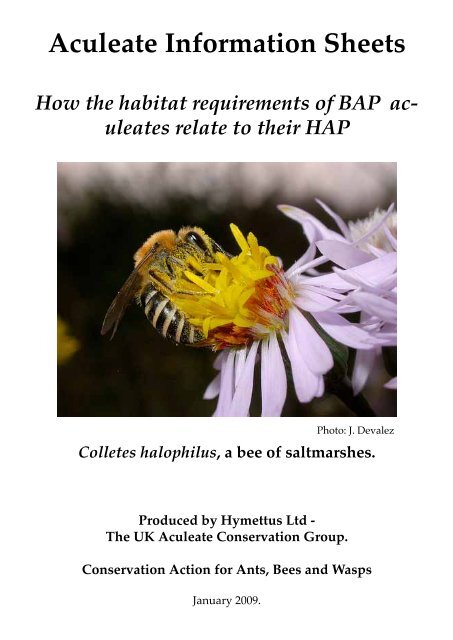Colletes halophilus - Hymettus
Colletes halophilus - Hymettus Colletes halophilus - Hymettus
Aculeate Information Sheets How the habitat requirements of BAP aculeates relate to their HAP Photo: J. Devalez Colletes halophilus, a bee of saltmarshes. Produced by Hymettus Ltd - The UK Aculeate Conservation Group. Conservation Action for Ants, Bees and Wasps January 2009.
- Page 2 and 3: General biology Colletes halophilus
- Page 4: A mating ball of males of Colletes
Aculeate Information Sheets<br />
How the habitat requirements of BAP aculeates<br />
relate to their HAP<br />
Photo: J. Devalez<br />
<strong>Colletes</strong> <strong>halophilus</strong>, a bee of saltmarshes.<br />
Produced by <strong>Hymettus</strong> Ltd -<br />
The UK Aculeate Conservation Group.<br />
Conservation Action for Ants, Bees and Wasps<br />
January 2009.
General biology<br />
<strong>Colletes</strong> <strong>halophilus</strong> is a mining bee which is associated uniquely with coastal saltmarshes<br />
and adjacent stabilised sandy dune areas, sea walls and low maritime cliffs.<br />
The bee has a very restricted range globally, and its association with salt marshes<br />
makes it particularly vulnerable to climate change, the associated rise in sea level and<br />
the policy outcomes associated with coastal management and sea defence.<br />
The bees are active in late summer and are on the wing in August and September. The<br />
female bees forage predominantly at the flowers of Sea-Aster (Aster tripolium). However,<br />
they will also visit flowers of other members of the plant family Asteraceae for nectaring,<br />
or when their preferred pollen source is unavailable.<br />
The nest burrows are excavated in stabilised sandy material with sparse vegetation<br />
cover to ensure maximum ground surface temperatures. In ideal sites, the nests may be<br />
formed into large aggregations numbering many thousands of individual burrows.<br />
Status in UK<br />
In UK, the bee is found along the North Sea and Channel coasts, from Spurn Point<br />
in the north, southwards through Lincolnshire, Norfolk, Suffolk, Essex, Kent, and then<br />
east through Sussex to Hampshire and the easternmost parts of Dorset. There is a single,<br />
anomalous, record from the Breckland heathlands.<br />
The bee nests close to its forage plants in suitable exposed places. Occasionally, large<br />
nesting aggregations can be found but these are rare in UK<br />
The bee was not listed in the Red Data Book 1 (1987), but was accorded Nationally<br />
Notable (a) status in the subsequent Review 2 (1991). The extreme localisation of the<br />
species, both nationally and globally, has resulted in it being included in the new BAP<br />
lists (2007)<br />
Reduction and degradation of salt marshes, strengthened existing coastal defences,<br />
expanding urban sprawl, continued development of brownfield sites, and inappropriate<br />
grazing regimes all place increasing pressure on this specialised bee species. Carefully<br />
considered and controlled “managed retreat” may, conversely, provide opportunities for<br />
conservation.<br />
1<br />
Shirt, DB (ed) 1987 British Red Data Books: 2. Insects. Nature Conservancy Council.<br />
2<br />
Falk, SJ 1991. A Review of the Scarce & Threatened Bees, Wasps & Ants of Great Britain.<br />
Research & survey in nature conservation, No. 35 Nature Conservancy Council
The Global distribution of <strong>Colletes</strong><br />
<strong>halophilus</strong><br />
<strong>Colletes</strong> <strong>halophilus</strong> is restricted to the<br />
Atlantic region of Europe, from the<br />
Friesian islands in the north to the<br />
south western Biscay coast of France.<br />
There are also important populations<br />
on the eastern and southern coasts of<br />
England<br />
(Map prepared from<br />
dataset)<br />
M. Kuhlmann<br />
The current distribution of<br />
<strong>Colletes</strong> <strong>halophilus</strong> in the UK<br />
Known from the south and<br />
east coasts of England, from<br />
Christchurch Harbour to Spurn<br />
Head. There is a single inland<br />
record from a sandy Breckland<br />
heath<br />
(Map prepared from BWARS<br />
dataset)
A mating ball of males of <strong>Colletes</strong> <strong>halophilus</strong> on sandy nesting substrate at<br />
Saeftinghe (NL). Photo N.L. Vereecken<br />
Key Points:<br />
• The bee has an extremely restricted distribution globally<br />
• The bee is liable to be vulnerable to rising sea levels<br />
• Effective management requires conservation action to protect the 2 partial<br />
habitats needed for nesting and foraging<br />
1. Stabilised exposures of sand or clay<br />
2. Large stands of Sea-Aster<br />
• The bee requires its key habitat components to be available on a landscape<br />
scale<br />
Printed and Distributed by <strong>Hymettus</strong> Ltd, Lea-Side, Carron Lane, Midhurst, GU29 9LB<br />
Registered Company No. 5761114. Registered Charity no. 1124636



